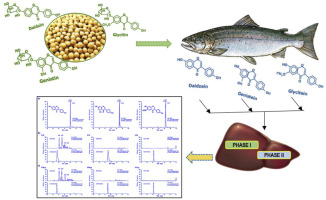当前位置:
X-MOL 学术
›
Ecotox. Environ. Saf.
›
论文详情
Our official English website, www.x-mol.net, welcomes your feedback! (Note: you will need to create a separate account there.)
Biotransformation of phytoestrogens from soy in enzymatically characterized liver microsomes and primary hepatocytes of Atlantic salmon.
Ecotoxicology and Environmental Safety ( IF 6.8 ) Pub Date : 2020-04-12 , DOI: 10.1016/j.ecoenv.2020.110611 Amritha Johny 1 , Lada Ivanova 1 , Tone-Kari Knutsdatter Østbye 2 , Christiane Kruse Fæste 1
Ecotoxicology and Environmental Safety ( IF 6.8 ) Pub Date : 2020-04-12 , DOI: 10.1016/j.ecoenv.2020.110611 Amritha Johny 1 , Lada Ivanova 1 , Tone-Kari Knutsdatter Østbye 2 , Christiane Kruse Fæste 1
Affiliation

|
Efficient aquaculture is depending on sustainable protein sources. The shortage in marine raw materials has initiated a shift to "green aquafeeds" based on staple ingredients such as soy and wheat. Plant-based diets entail new challenges regarding fish health, product quality and consumer risks due to the possible presence of chemical contaminants, natural toxins and bioactive compounds like phytoestrogens. Daidzein (DAI), genistein (GEN) and glycitein (GLY) are major soy isoflavones with considerable estrogenic activities, potentially interfering with the piscine endocrine system and affecting consumers after carry-over. In this context, information on isoflavone biotransformation in fish is crucial for risk evaluation. We have therefore isolated hepatic fractions of Atlantic salmon (Salmo salar), the most important species in Norwegian aquaculture, and used them to study isoflavone elimination and metabolite formation. The salmon liver microsomes and primary hepatocytes were characterized with respect to phase I cytochrome P450 (CYP) and phase II uridine-diphosphate-glucuronosyltransferase (UGT) enzyme activities using specific probe substrates, which allowed comparison to results in other species. DAI, GEN and GLY were effectively cleared by UGT. Based on the measurement of exact masses, fragmentation patterns, and retention times in liquid chromatography high-resolution mass spectrometry, we preliminarily identified the 7-O-glucuronides as the main metabolites in salmon, possibly produced by UGT1A1 and UGT1A9-like activities. In contrast, the production of oxidative metabolites by CYP was insignificant. Under optimized assay conditions, only small amounts of mono-hydroxylated DAI were detectable. These findings suggested that bioaccumulation of phytoestrogens in farmed salmon and consumer risks from soy-containing aquafeeds are unlikely.
中文翻译:

大豆中植物雌激素的生物转化,其特征在于具有酶学特征的大西洋鲑鱼肝微粒体和原代肝细胞。
有效的水产养殖取决于可持续的蛋白质来源。海洋原料的短缺已开始转向以大豆和小麦等主要成分为基础的“绿色水产饲料”。由于可能存在化学污染物,天然毒素和诸如植物雌激素的生物活性化合物,基于植物的饮食给鱼类健康,产品质量和消费者风险带来了新的挑战。大豆黄酮(DAI),金雀异黄素(GEN)和糖蛋白(GLY)是主要的大豆异黄酮,具有相当大的雌激素活性,可能会干扰鱼的内分泌系统,并在结转后影响消费者。在这种情况下,有关鱼类中异黄酮生物转化的信息对于风险评估至关重要。因此,我们分离了大西洋鲑(Salmo salar)的肝部分,是挪威水产养殖中最重要的物种,并用于研究异黄酮的消除和代谢产物的形成。鲑鱼肝微粒体和原代肝细胞的特征在于使用特定探针底物的I期细胞色素P450(CYP)和II期尿苷-二磷酸-葡糖醛酸糖基转移酶(UGT)酶活性,可与其他物种的结果进行比较。DAI,GEN和GLY被UGT有效清除。基于液相色谱高分辨率质谱仪中精确质量,片段化模式和保留时间的测量,我们初步确定了7-O-葡糖醛酸苷是鲑鱼的主要代谢产物,可能是由UGT1A1和类似UGT1A9的活性产生的。相反,CYP产生的氧化代谢产物微不足道。在优化的测定条件下,仅检测到少量的单羟基化DAI。这些发现表明,养殖鲑鱼中植物雌激素的生物蓄积和含大豆水产饲料的消费者风险不太可能。
更新日期:2020-04-13
中文翻译:

大豆中植物雌激素的生物转化,其特征在于具有酶学特征的大西洋鲑鱼肝微粒体和原代肝细胞。
有效的水产养殖取决于可持续的蛋白质来源。海洋原料的短缺已开始转向以大豆和小麦等主要成分为基础的“绿色水产饲料”。由于可能存在化学污染物,天然毒素和诸如植物雌激素的生物活性化合物,基于植物的饮食给鱼类健康,产品质量和消费者风险带来了新的挑战。大豆黄酮(DAI),金雀异黄素(GEN)和糖蛋白(GLY)是主要的大豆异黄酮,具有相当大的雌激素活性,可能会干扰鱼的内分泌系统,并在结转后影响消费者。在这种情况下,有关鱼类中异黄酮生物转化的信息对于风险评估至关重要。因此,我们分离了大西洋鲑(Salmo salar)的肝部分,是挪威水产养殖中最重要的物种,并用于研究异黄酮的消除和代谢产物的形成。鲑鱼肝微粒体和原代肝细胞的特征在于使用特定探针底物的I期细胞色素P450(CYP)和II期尿苷-二磷酸-葡糖醛酸糖基转移酶(UGT)酶活性,可与其他物种的结果进行比较。DAI,GEN和GLY被UGT有效清除。基于液相色谱高分辨率质谱仪中精确质量,片段化模式和保留时间的测量,我们初步确定了7-O-葡糖醛酸苷是鲑鱼的主要代谢产物,可能是由UGT1A1和类似UGT1A9的活性产生的。相反,CYP产生的氧化代谢产物微不足道。在优化的测定条件下,仅检测到少量的单羟基化DAI。这些发现表明,养殖鲑鱼中植物雌激素的生物蓄积和含大豆水产饲料的消费者风险不太可能。


























 京公网安备 11010802027423号
京公网安备 11010802027423号